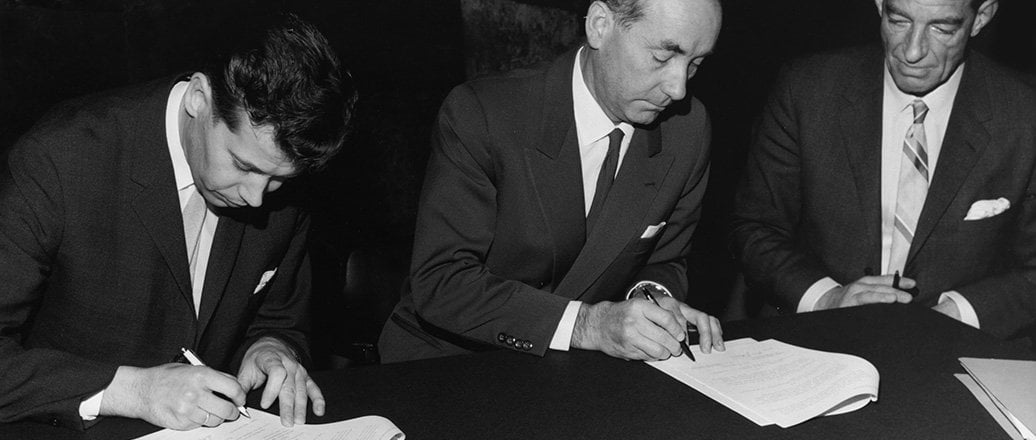Management kept their distance from their workforce in the 1960s, and in some respects had different interests. Although employees had been represented on Hydro’s board for some time, employee democracy was a concept that had not yet been put into practice to any significant degree.
The Herøya works council held a meeting in September 1966 to discuss a new cooperation agreement. This formed part of the joint wage agreement between the management and the unions, and resulted in a request for a meeting with Hydro’s top management to discuss Human Resources and cooperation issues.
The meeting took place on 13 December 1966. Afterwards Johan B. Holte, soon to become managing director of Hydro, commented that he had got on very well with the head of the Herøya union, Tor Halvorsen; that they understood each other. It was their joint understanding that paved the way for what became known as the productivity agreement they signed two years later.
“In a large company such as this, there is always the question of rationalization, increasing efficiency, productivity and profits. But inseparable to these issues are the factors of cooperation, work satisfaction and the best possible utilization of human resources,” said Holte.
6,500 employees at Herøya
At this point, Hydro had 10,000 employees in Norway and 6,500 of these worked at Herøya. The productivity agreement was based on a joint understanding of the importance of rationalization, increased efficiency and cost awareness in the company. It was also agreed that the consultancy company Habberstad would visit all departments to identify the best and most efficient approach to manning reductions.
A productivity bonus of NOK 0.50 (EUR 0.06 at 2003 exchange rate) was established, in addition to other bonus arrangements. This was the first time in Norway that a local union had entered into an agreement of this type with a company, and was an item on the national TV news.
The productivity agreement also included a system for planning and assessing maintenance. Personnel were trained and given the responsibility for ensuring that the system functioned as it should. This resulted in better planning and performance, and formed the basis for performance related pay. However the system had a weakness in that it depended on measurement and control – without taking into consideration personal motivation and creativity.
The Norwegian Federation of Trade Unions was set up in 1966, and “cooperation trials” were introduced in Norwegian industry, with a view to increasing employees’ influence on their own work situation.
The cooperation trials, developed by Einar P. Thorsrud at the work research institute in Oslo, assessed the workplace in relation to the following psychological factors :
- Meaningful job content
- Being able to learn through the job
- Being able to take decisions
- Recognition, at the very least some support and respect
- Ability to see a link between the job and the world outside
- Ability to see the job in the concept of a positive future vision.
The cooperation trials at Herøya started in the NPK and carbide factories, followed by the electrolysis unit in Magnesium.
The experiences gained from the trials in the NPK factory were summarized at the end of 1967. Tor Halvorsen in the Herøya union had been sceptical, he said, but now he saw that “the results outstrip our expectations. It’s clear that a quite new approach has been established”. Halvorsen felt this was most clearly seen in the interest in implementing measures where needed.
Holte wanted to reduce the differences in interests: “The most important thing is not the immediate increase of productivity and financial return, but that people and personal values come to the fore (...) This means a democratization of working life through greater knowledge and better collaboration.”
Both theory and practice
This work continued. A training programme was set up at the factory school that combined theory with systematic practical training. The productivity agreement was renewed in 1970, and the new version included a clause on training. This was combined with the cooperation trials to form a five-level training programme involving 600 teaching hours, which was again further developed into an internal certificate of apprenticeship for chemical and process industry. This was the precursor of the public apprentice certificate.
The focus on cooperation made Hydro a pioneer company in this area, and delegations came to Herøya from all over the world. The NPK factory was frequently referred to as the star unit, but there were several other units at Herøya, where the cooperation trials left a permanent mark.
Hydro has always recognized the right of its employees to join unions. The cooperation trials helped to improve the relationship between management and employees and their unions.
Updated: March 8, 2019








